If you're planning a SOC 2 compliance audit, the first thing you’ll want to know is how long it takes. You’ll want an account of how long each phase lasts, what drives that timeline, what slows it down, and what helps you move faster.
SOC 2 is structured, but no two timelines look the same. Your readiness, internal systems, and even the type of audit you choose will all shape the pace. That’s why it’s worth getting a real-world picture before locking in dates.
This guide breaks the timeline into clear phases. We’ll show you what to expect at each step, how long each phase typically runs, and what decisions can help you shorten or extend the duration.
We’ll also dig into the preparation phase in detail, because that’s where most delays happen. Planning too late or rushing through readiness often results in longer audits or missed deliverables.
Understanding each step lets you move with intent, allocate the right team effort, and align your compliance goals with business outcomes like enterprise sales or investor diligence.
Let’s start with why this timeline matters more than it seems on the surface.
Why Understanding Your SOC 2 Timeline Matters
The SOC 2 audit process affects your product, sales, and hiring timelines more than you expect. If you plan for 3 months and it takes 9, the missed expectations create internal friction and slow your external momentum.
If you’re fundraising or selling into an enterprise, buyers will ask when your SOC 2 report will be ready. You need to give them a credible timeline that accounts for preparation, observation, and audit.
Getting the timeline wrong delays the audit and creates a backlog of dependencies. Engineers wait for evidence gathering. Legal waits on vendor reviews. Sales gets stuck on customer security calls.
Understanding how long SOC 2 takes at each stage lets you parallelize work more efficiently. You can also scope your first audit to match where your company is operationally, instead of overreaching and getting stuck.
Timelines also affect cost. If your audit drags past a quarter, that’s another cycle of tooling, internal time, and potentially missed deals. Compression saves budget.
So, before you commit to any audit type, software vendor, or control scope, map the time cost of each decision. It’ll help you avoid expensive overestimation or reputation-damaging underdelivery.
Now that you understand the stakes, the next step is to choose your starting point: Type 1 or Type 2.
Type 1 vs Type 2 at a Glance
Type 1 is faster because it’s a point-in-time assessment. Auditors only test whether your controls are designed correctly, not whether they operate effectively over time.
Type 2 takes longer because it includes an observation period. You’ll need to run your controls continuously for at least three months, and more commonly six to twelve, before the audit even begins.
Most startups use Type 1 to get initial credibility with customers, then go for Type 2 as they scale. You can think of Type 1 as a launchpad and Type 2 as the operational proof.
Here’s how the duration typically breaks down:
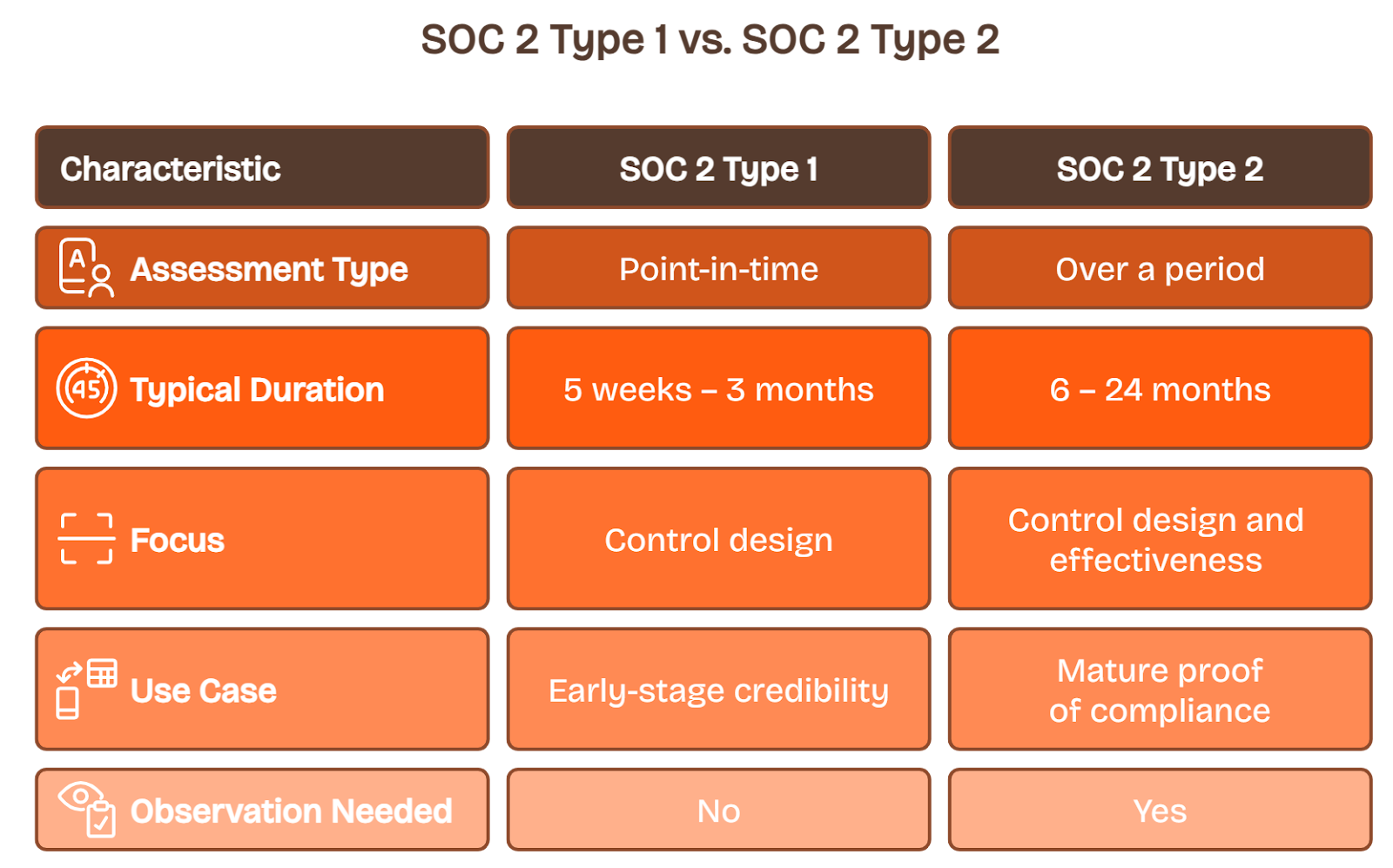
The longer you wait to define which type fits your current maturity, the harder it becomes to set clear targets across teams.
Read: SOC 2 Type 1 vs Type 2: Detailed Comparison
Next, let’s dig into the first and often most time-consuming part of the process: your readiness phase.
Phase 1 – Pre-Audit Preparation & Readiness Assessment
This is where most teams underestimate the work involved. Before your auditor even starts looking at your systems, you need to ensure that your house is in order.
The readiness phase involves documenting, implementing, and aligning your security controls across people, processes, and tech. It’s where delays happen most frequently.
Your timeline here depends on company size, system complexity, and how far along you already are with internal controls.
Let’s look at each part of this phase step by step.
Readiness Assessment (~ 2 to 6 Weeks)
The readiness assessment gives you a baseline of where you stand against SOC 2 requirements. It’s usually the first step compliance vendors or auditors will recommend.
You’ll walk through each trust criteria, review policies, and identify what’s missing. The goal is to reduce surprises later during the actual audit window.
Expect 2 to 6 weeks for this stage if you work with a partner or platform that knows what to look for.
Here’s a timeline comparison depending on the company size:
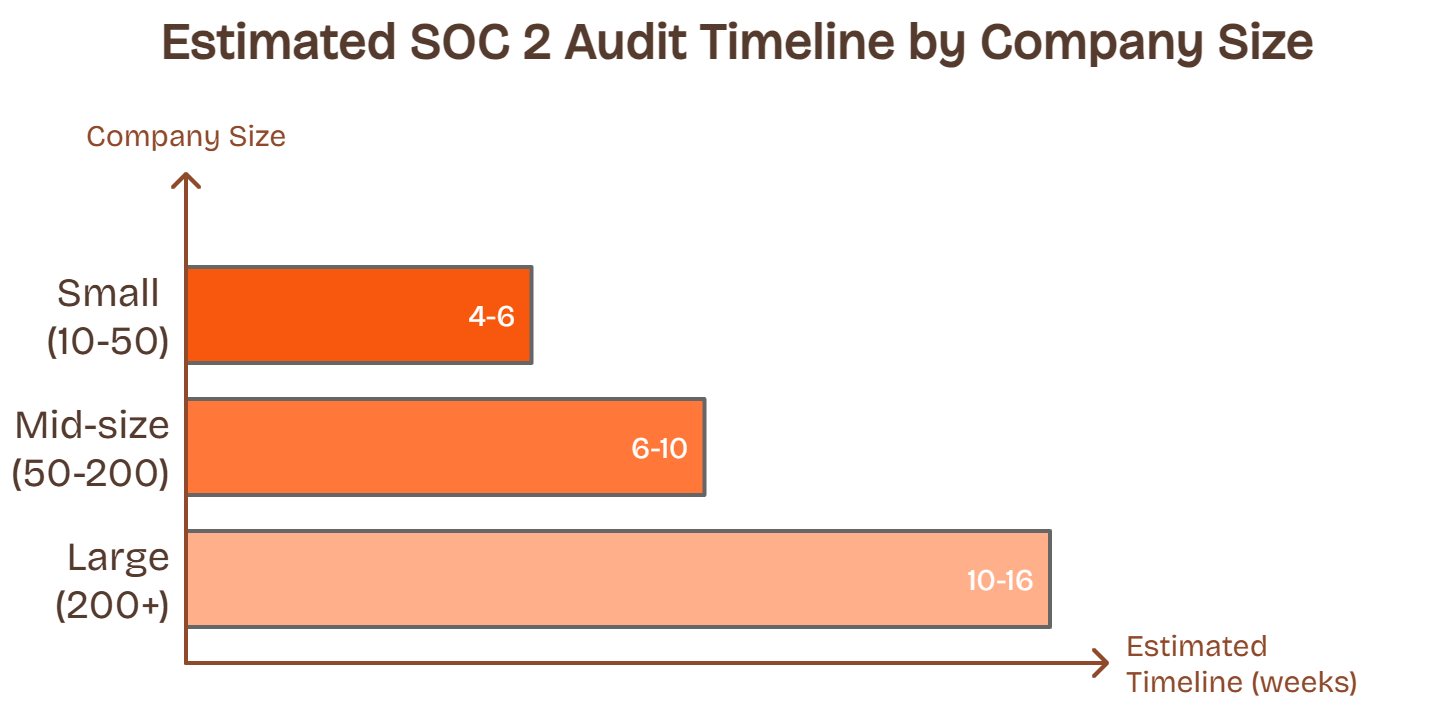
Your team should include a technical owner, a compliance lead, and support from IT and HR. The more cross-functional the effort, the less cleanup you’ll have later.
If you’re managing this internally without automation, assume the upper end of these timelines.
Read: SOC 2 Automation Software
Gap Analysis & Remediation (~ 2 to 5 Weeks)
Once you complete the readiness review, your next step is to fix what’s missing. This is the gap analysis and remediation phase, which can take an additional 2 to 5 weeks.
You’ll likely need to:
- Draft or update security policies
- Configure cloud infrastructure monitoring
- Rework access control or onboarding flows
- Roll out training and acceptance logging
All of that adds up. The average company spends another 1 to 3 months remediating before controls are actually in place.
Use this checklist to guide your pre-audit remediation:
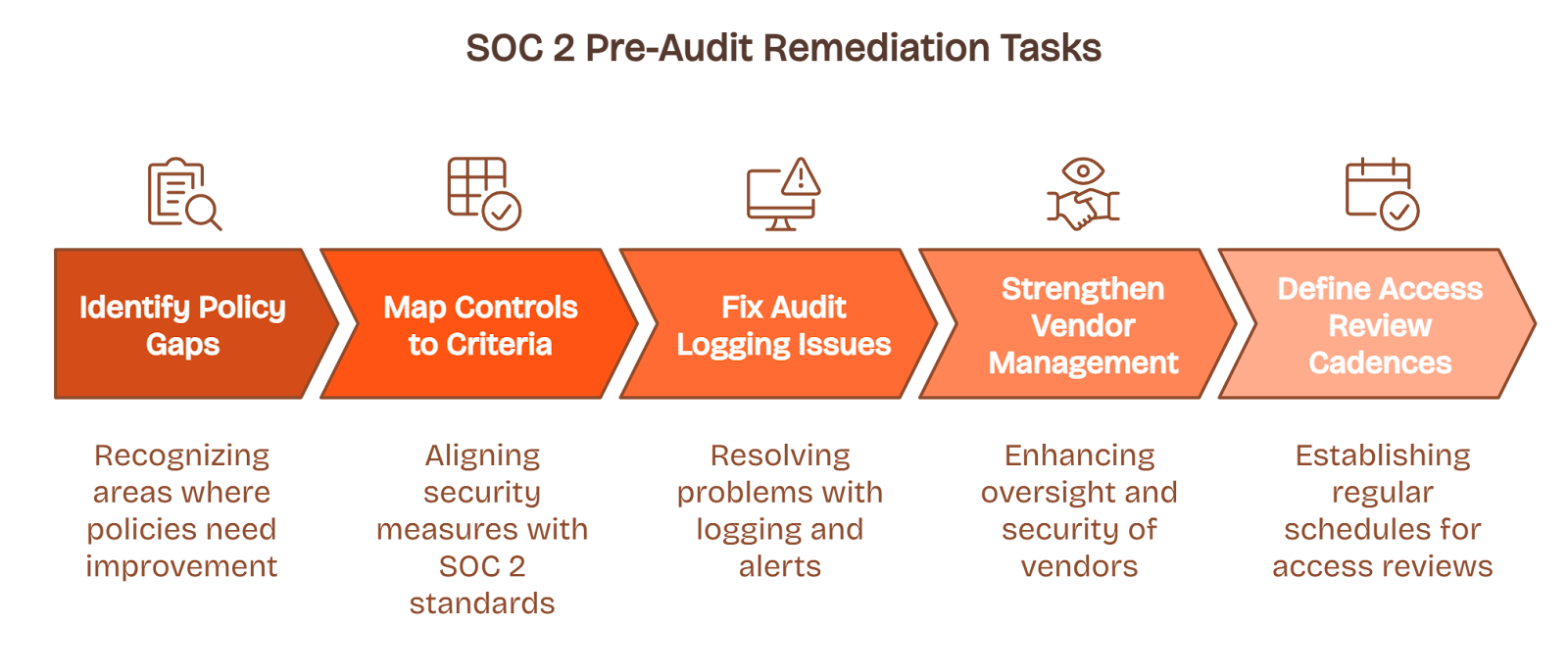
Having a pre-audit checklist avoids random gaps from dragging the audit into longer cycles.
Read: SOC 2 Compliance Requirements: End-to-End Guide
Controls Implementation (~ 2 to 6 months)
Once gaps are clear, you’ll start implementing the actual controls. This is the backbone of your SOC 2 compliance. Without it, the audit can’t proceed.
The implementation window varies a lot based on how many controls you’re missing and whether you use automation tools.
Manual implementation can stretch to six months.
Policy documentation alone can take a full quarter if done from scratch. Pre-built templates help, but tailoring them to your environment still takes time.
You’ll need engineering time to configure access reviews, alerts, logging, and more. Most teams underestimate how many hours this eats up in practice.
Control implementation timeline snapshot:
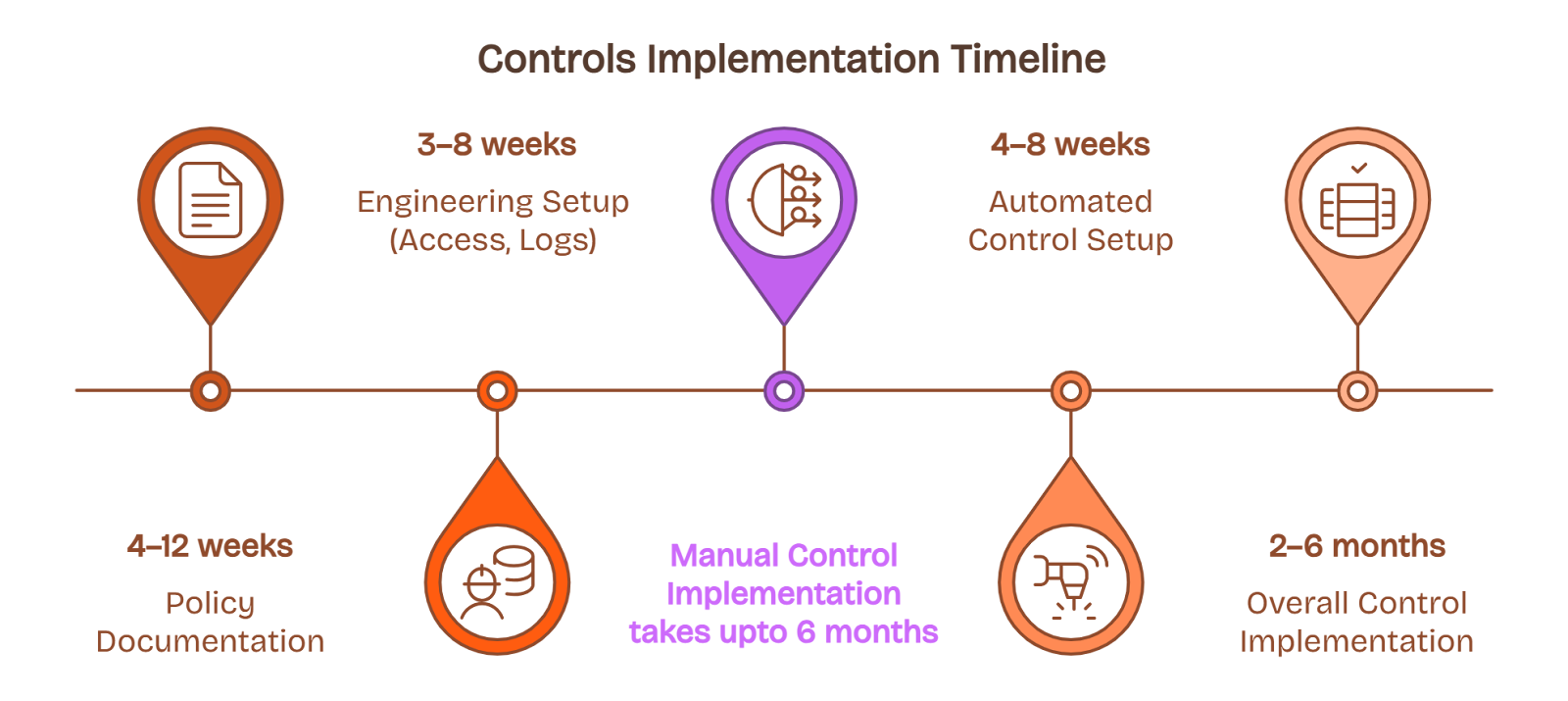
The longer you delay here, the more pressure you’ll feel during the observation period or final audit. The more you frontload it, the faster the rest moves.
Read: SOC 2 Control list
Policy Documentation (~ 1 to 3 months)
A common delay during SOC 2 prep is documentation. Even if your controls work, auditors need proof that your team follows a defined process.
Expect to spend 1 to 3 months drafting, reviewing, and finalizing documentation for security, availability, and confidentiality controls.
Strong documentation helps clarify intent, show consistency, and reduce audit exceptions.
Risk Assessment & Pen Testing (~ 2 to 4 weeks)
Two critical steps often overlooked are your risk assessment and penetration testing.
A formal risk assessment typically takes 2 to 4 weeks, depending on how many assets and vendors you need to evaluate. It involves mapping threats, identifying control gaps, and scoring risks by likelihood and impact.
Penetration testing, though shorter in duration, still needs coordination. You’ll need to scope it, hire an approved vendor, and review the report, all of which takes 2 to 3 weeks.
Here’s the taskwise breakdown:
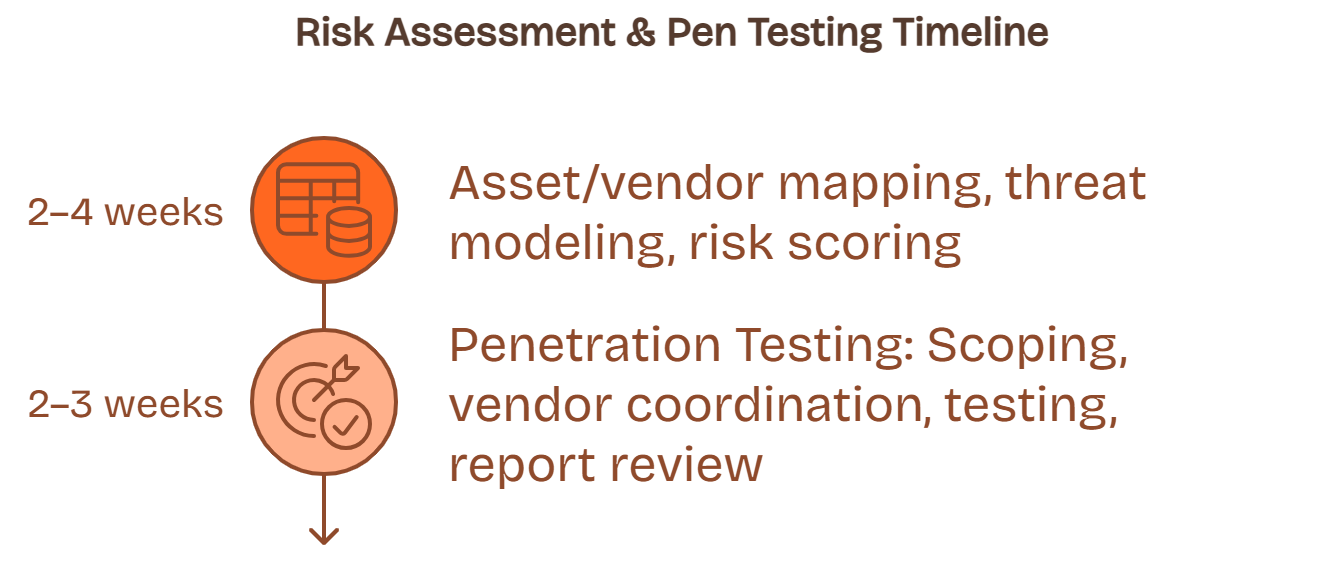
If you start these too late, they’ll push your entire audit timeline out because auditors require finalized reports during evidence collection.
Bridging Into the Observation Period
Once your controls are in place and your documentation is audit-ready, you can start your observation period if you’re going for Type 2.
If you’re stopping at Type 1, this is when you schedule your audit engagement. Either way, everything up to this point determines how soon you can move forward.
Now we’ll explore the next phase.
Read: What is a bridge letter?
Phase 2 – How long does a SOC 2 Type 1 Audit Take?
The Type 1 audit gives you a snapshot. It's your system's state on a particular date. Most early-stage teams start here to meet urgency from deals or investors, since it's the shortest path to a SOC 2 report.
You’ll split the timeline into two zones: preparation and audit execution. Most of your time goes into prep. The audit itself is fast if your evidence is in place.
Preparation vs. Examination Window
Expect 2 to 6 weeks for prepping artifacts, evidence, and policies. The audit firm needs 1 to 3 weeks for review and final opinion. Faster if you're using a compliance automation tool.
Evidence Collection & Control Testing
You collect documentation showing controls exist and are functioning as of a single point in time. No historical data needed, so it's lighter than Type 2.
Report Opinion & Delivery
Once testing is complete, the CPA firm issues the report within 1 to 2 weeks.
SOC 2 Type 1 audit Timeline at a glance:
Phase 3 – SOC 2 Type 2 Audit: Observation & Reporting Period
Type 2 takes the Type 1 foundation and stretches it across time. You're no longer providing a snapshot. You’re proving sustained operation of controls over 3 to 12 months.
Observation Window
You’ll pick a defined timeframe to monitor and test your controls. The industry standard is 3 to 6 months for first-time audits. 12-month windows are typical for renewals.
First-Time vs. Renewal Comparison
For first-time audits, shorter windows (3 or 6 months) allow faster turnaround. Once you're in steady state, the full-year audit becomes the norm.
Continuous Monitoring Impact
If you’re using automated audit runners or agent-based monitoring, you’ll cut the time and friction during observation. Manual workflows drag this out.
Evidence Collection Throughout
Unlike Type 1, here you’re showing ongoing effectiveness. This means logs, change records, tickets, and test results must span the full period.
Ongoing Control Testing Duration
CPA firms typically test control samples from each month in the window. You need clean, timestamped data for the whole period to avoid delays.
SOC 2 Type 2 Audit timeline at a glance:
Next, we’ll break down post-audit deliverables and how to keep your controls audit-ready year-round.
Phase 4 – Formal Audit & Report Finalization
This phase is where the auditor tests your real-world evidence and issues the formal report. It’s the final stretch, and the accuracy of what you’ve logged over months gets validated here.
Comprehensive Evidence Gathering
Auditors request artifacts that span the observation window. Expect 30 to 60 documents, depending on the scope. This includes logs, access reviews, vendor checks, and incident records.
Control Testing & Sampling
Auditors test your controls by sampling activity across the audit period. For example, if your window is 6 months, they'll request 1–2 samples per control per month. Missing or inconsistent logs cause back-and-forth.
Report Writing & Management Review
After control testing, the auditor drafts the SOC 2 report. They’ll flag exceptions, document control design, and validate evidence against criteria. Your management provides a written assertion. Expect 2 to 4 weeks for review, revisions, and final delivery.
Totally, the formal audit and report finalization would take you from 2 to 4 weeks.
Now let’s look at the annual renewal timelines.
Phase 5 – Annual Renewal & Certificate Validity
SOC 2 reports expire in practical terms after 12 months. You’re expected to renew annually to stay credible with customers and partners. Renewals are smoother if you’ve maintained audit hygiene.
Preparation for Renewal (2–4 weeks)
About a month before your current report’s end date, start prepping for the next audit cycle. Revisit control mappings, evidence templates, and changes in systems or team structure.
Ongoing Observation & Monitoring (12 months)
The new audit picks up where the previous one left off. You’ll again define an observation window, ideally 12 months this time. Continuous monitoring tools reduce evidence gaps and ease the burden.
Re-audit & Opinion Delivery (3–6 weeks)
Once your observation window ends, the formal audit process begins again. Most teams take 3 to 6 weeks for evidence review, control testing, and report finalization.
Refer to this quick initial and renewal phase comparison to grasp the whole process outline:
Next, we’ll explore how automation platforms impact audit readiness and timelines over the long term.
Factors Influencing Your SOC 2 Compliance Time
Your audit timeline is mainly shaped by how ready your systems are, how complex your operations look to an auditor, and how broad your compliance goals are. Timeframes vary by scope, size, and maturity. Let’s see how.
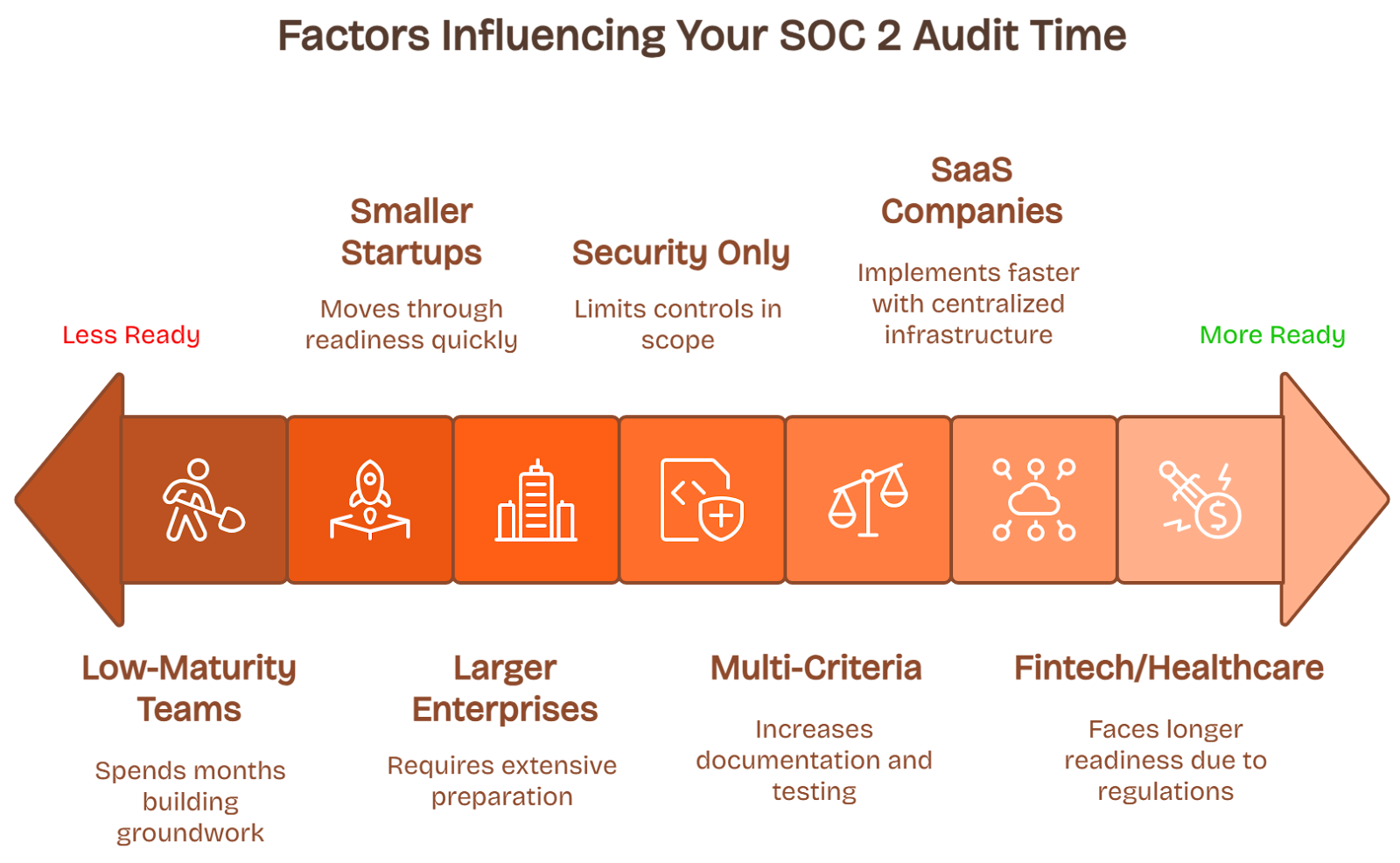
Organizational Readiness
If you’ve already invested in access controls, onboarding workflows, logging systems, and vendor management, your baseline maturity shortens audit prep by weeks. Low-maturity teams often spend 3 to 6 months building groundwork.
Company Size & Complexity
Smaller startups can move through readiness in 4 to 8 weeks, especially with automation.
Larger enterprises with hybrid infrastructure, internal IT, and multiple departments often require 12 to 20 weeks before they’re ready to audit.
Trust Services Criteria Scope
Going for Security only limits the number of controls in scope. Expanding to include Availability, Confidentiality, or Privacy increases documentation and testing time.
Multi-criteria audits often take 30 to 50% longer than Security-only audits.
Industry-Specific Variations
SaaS companies with centralized infrastructure and API-first tooling tend to implement faster. Fintech and healthcare teams face longer readiness windows due to added vendor scrutiny, encryption requirements, and legal controls.
Strategies to Accelerate Your SOC 2 Audit Timeline
There’s no one-click shortcut, but there are proven methods to reduce friction, avoid delays, and create audit momentum early as displayed here.
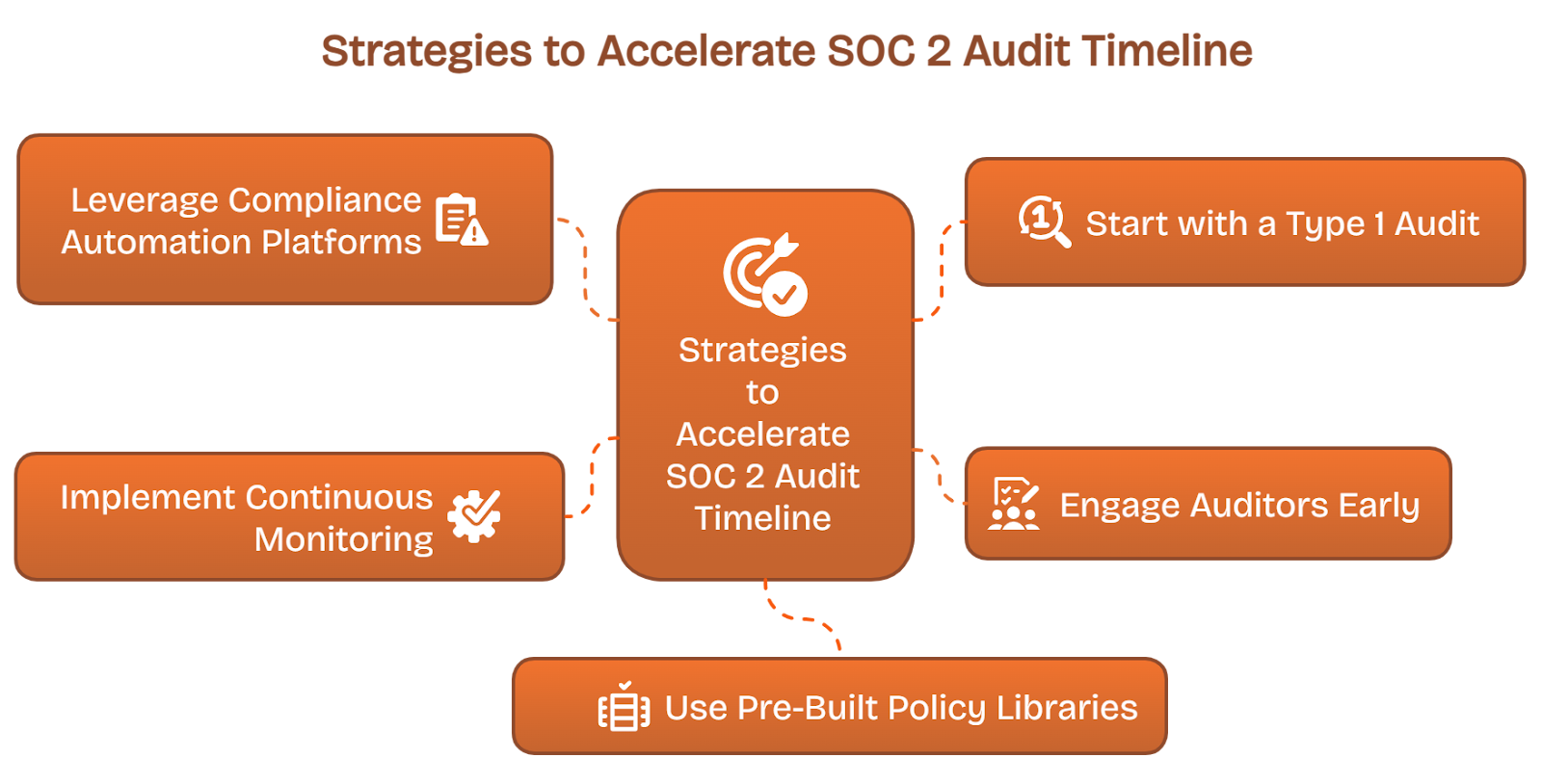
Leverage Compliance Automation Platforms
Tools like ComplyJet automate evidence gathering, alert on control drift, and provide auditor dashboards. This saves 40 to 60% of manual effort during readiness and evidence collection.
Start with a Type 1 Audit
If you're new to SOC 2, begin with a Type 1 audit. It evaluates control design at a point in time and typically wraps in 4 to 6 weeks. It gets you a report faster and helps build customer trust while you prepare for Type 2.
Engage Auditors Early for Scope & Evidence Guidance
Many teams delay auditor engagement until after readiness, which can cause rework. Instead, get audit firms involved at the planning stage. Ask for control expectations, document samples, and sampling assumptions up front.
Implement Continuous Monitoring from Day 1
Rather than wait until the observation window begins, use monitoring tools early. This helps you fix gaps in real time and ensures you're not missing logs or approvals during the audit period.
Use Pre-Built Policy & Procedure Libraries
Drafting every policy from scratch adds weeks. Use templates from your automation platform, tailored by compliance consultants, to cover access, change management, incident response, and more.
Read: SOC 2 Compliance
Now let’s look at these timeline examples that directly inform which path would suit your organisation.
Real-World Timeline Examples
Typical First-Time Type 2 Path (Months 1–18)
A mid-stage SaaS startup began with no existing controls in place. This is their SOC 2 audit timeline.
Accelerated Track with Automation (Months 1–10)
A high-growth fintech used an automation platform from day one. This is how much time an automation platform saved.
ComplyJet can do this for you and more. It helps you move even faster without the bloated costs or manual drag.
Complete Type 1 audits in under a month: Smart task automation accelerates evidence collection and closes gaps quickly with instant AI-based readiness assessments and prebuilt policy templates
All starting at just $4,999/year: Covers 3+ frameworks and full access to AI assistance from day one
Shorten the Type 2 window by 40–50%: Continuous control monitoring starts on Day 1 with 100+ native integrations
Finalize reports faster with zero chaos: Automated evidence logging and auditor-friendly dashboards streamline the final processes
Here’s the snapshot of our timeline:
Start our FREE TRIAL now!
Small Business vs. Enterprise Comparison
We’ve also laid out a comparison chart to properly track your SOC 2 timeline by its stage and your organisation’s size:
FAQ
What is the shortest timeline for a SOC 2 audit?
A Type 1 audit can be completed in as little as 4–6 weeks if controls are in place. Type 2 audits take a minimum of 3 months due to the observation period requirement.
How many months to complete SOC 2 compliance?
Timelines range from 6 to 18 months, depending on readiness, scope, and use of automation. Most teams average 9–12 months for full Type 2 compliance.
How long is a SOC 2 report valid for?
SOC 2 reports are valid for 12 months from the end of the audit period. Renewal requires ongoing compliance and a fresh audit each year.
Can automation reduce my SOC 2 audit duration?
Yes. Compliance platforms can reduce evidence collection, control tracking, and audit prep time by 40–60%, enabling faster readiness and smoother audits.
What is a typical SOC 2 audit duration checklist?
- Control mapping: 1–2 weeks
- Tool setup: 2–4 weeks
- Policy deployment: 1–3 weeks
- Auditor selection: 2–3 weeks
- Observation window: 3–12 months
- Final audit + reporting: 3–6 weeks
Key Takeaways
- Budget 6–18 months for your first SOC 2 Type 2 journey
- The readiness phase is your biggest time sink, so invest in strong foundations
- Automation and early prep can cut audit time by up to 50%
- Engaging auditors early minimizes rework and deadline risk
Ready to map out your SOC 2 journey?
Here’s our SOC 2 Compliance Checklist to get you started!
.png)


